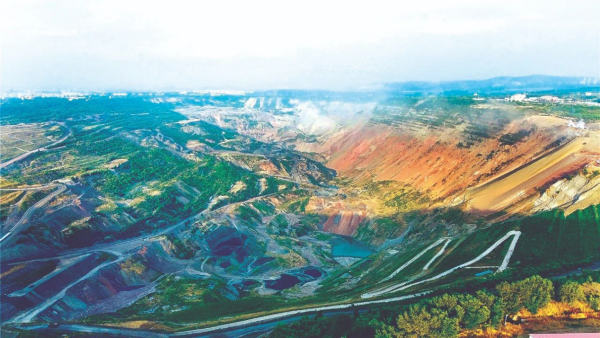Located in Fuxin City in Northeast China’s Liaoning Province, the Haizhou Open-Pit Coal Mine boasts a glorious history.
Established in 1953, the mine, often referred to as the "living fossil" of China's coal industry, was the second-largest open-pit coal mine in the world and the largest in Asia at the time. Over more than half a century, it produced 244 million tons of coal, generating industrial value close to 100 billion yuan ($13.9 billion). Its iconic mining scenes were even immortalized on the old five-yuan banknotes, serving as a timeless symbol of China's industrialization.

The Haizhou Open-Pit Coal Mine in Fuxin City has become an “ecological landmark.” [Photo/sasac.gov.cn]
However, in 2005, the mine ceased operations due to depleted resources, leaving behind a scar equivalent to 38 Forbidden City complexes. In 2009, the site was transformed into the National Mine Park in an attempt to revitalize the area.
In 2023, CCTEG Ecological Environment Technology Co., Ltd., a subsidiary of China Coal Technology and Engineering Group (CCTEG), which is a state-owned enterprise that provides comprehensive services and products for the coal industry in China and abroad, collaborated with the Fuxin Municipal People’s Government to address the environmental issues at the Haizhou Open-Pit Mine.
The company proposed a comprehensive plan encompassing geological disaster management, ecological restoration, and resource utilization to tackle issues such as slope deformation, subsidence, and ecological deterioration.
The establishment of the Haizhou Open-Pit Mine Comprehensive Management Project in March 2024 marked the beginning of the transformation from a "city scar" to a "city green lung." Through innovative techniques like integrated aerial surveys and ground inspections, the team identified and addressed 65 high-temperature fire points and mapped the underground voids accurately, addressing longstanding geological hazards.
Facing challenges such as complex terrain, weathered rock layers, and high surface temperatures, the team devised a groundbreaking method combining directional drilling and grouting to stabilize the slopes effectively. The successful implementation of this technique resolved a significant geological hazard, setting a precedent for closed open-pit mines in China.
To enhance the tourism value of the National Mine Park, a scenic eco-trail spanning 8.2 kilometers with landscaped trees and viewing platforms was constructed along the collapsed slopes, attracting locals and visitors for leisure activities and photography.
The once avoided mining pit has now evolved into a preferred recreational spot for Fuxin residents, transforming from a "city scar" into an "ecological landmark."
Currently, efforts are still underway to upgrade the area into a carbon-neutral factory and scenic spot by integrating renewable energy, coal gangue utilization, and cultural tourism, promoting a shift from a "deep brown" industrial structure to a "deep green" low-carbon economy.
(Executive editor: Yuan Ting)